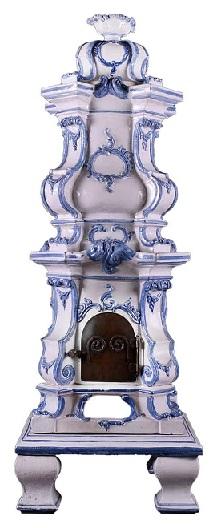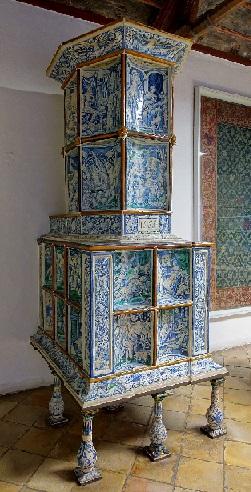This is an example of a large and impressive "Kachelofen" (ceramic stove) from the 19th century. The shaped feet surmounted by substantial burning chamber with arched copper door. Ornate ceramic embellishments throughout, painted with blue trim. German origin. Some very minor restorations required, included in price.

Kachelofen is a type of masonry stove made out of specialized stove tiles and other refractory materials and originates from central Europe. Unlike brick finished or rendered stoves, kachelofen stoves usually have higher surface temperature, depending on their design characteristics.
Just as there are different types of masonry stoves, there are different types of kachelofen - for simplicity we can categorize them as light, medium and heavy and also single or double skin. These distinctions are useful and important when choosing the stove, its size, shape and nominal heating time - how long the stove stays warm for. Just like other masonry stovesthey have a system of flues inside it which extracts the heat which is then stored and released into the house.
Making stove tiles is a highly specialised and skilled job and different techniques vary from person to person. Tiles can be either pressed or poured into moulds or hand rolled and cut using fire clay. Tiles are then glazed or hand painted using glazes from naturally occurring minerals. Refractory heat channels are then designed and built in line with client's preferences and requirements and also with mason's experience - some stove builders prefer to use traditional building techniques and clays, whilst others choose modern materials, newly developed mortars or even metal inserts. The result is a unique stove that suits the house and serves its purpose, whether is it heating, cooking or baking.
Kachelofen can be either individually designed or made to look like one of the original stoves as far back as few centuries. Antique kachelofen (or kakelugn, as they are known in Scandinavia) are popular choice in period interiors and because they were originally built using just clay and sand, they can be dismantled, moved and rebuild again, only this time with new system of internal flues
At the end of the tour of, Neuschwanstein, the world's most famous castle you will see their famous stove. It was built in 1880 and done in neo-Romanesque style. Only the rich could afford a stove that is designed by an architect. The architect, Julius Hofmann had designed three elaborately decorated tiled stoves for the residential rooms in the castle, adapted to the style of the rooms: Gothic for the bedroom and Romanesque for the dressing room and the salon. King Ludwig was only satisfied with one and this stove was stored without ever being used.
The stove is typical of the 19th century with respect to size. But it is built like a tower with a square pedestal and elaborate late Romanesque ornamentation (jagged style) and crowned with a lantern dome. Round the octagonal middle section, matching the theme of the salon are plaques with the words "Fides" (Faith), "Caritas" (Love), and "Spes" (Hope). This stove is a good example of the inventiveness and creativity of historicism: there are no Romanesque forerunners for a design of this kind.

To find out more about this piece please visit our website where you can view it & many other rare & unusual marbles.


